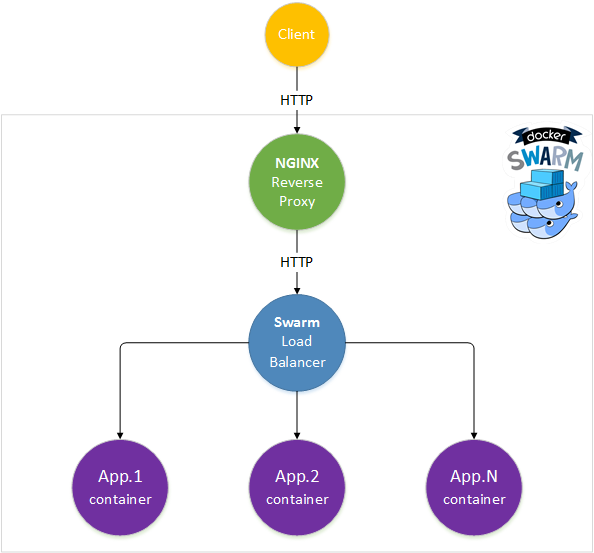This tutorial shows how you can set up NGINX as a reverse proxy for ASP.NET Core. As you probably know, the Kestrel web server that hosts your ASP.NET Core applications is not meant to be an internet-facing server. By using NGINX in front of Kestrel you can provide SSL termination, compression and caching for your web apps.
You will be running the reverse proxy and web app in containers on a Docker Swarm cluster. The NGINX reverse proxy will forward the requests to your app service and Docker Swarm will load balance the requests between your app instances.

I’m using a Windows 10 machine for development but you can follow this tutorial on a Mac or Linux device using Visual Studio Code and Docker.
Windows 10 prerequisites:
Let’s start by creating an ASP.NET Core app named APPX and adding a Dockerfile in the root directory. If you’ll use Yeoman generator for ASP.NET the Dockefile will be generated for you.
FROM microsoft/dotnet:latest
# Set environment variables
ENV ASPNETCORE_URLS="http://*:5000"
ENV ASPNETCORE_ENVIRONMENT="Staging"
# Copy files to app directory
COPY /src/APPX /app
# Set working directory
WORKDIR /app
# Restore NuGet packages
RUN ["dotnet", "restore"]
# Build the app
RUN ["dotnet", "build"]
# Open port
EXPOSE 5000/tcp
# Run the app
ENTRYPOINT ["dotnet", "run"]
Open PowerShell, navigate to your project root directory and build the APPX image:
docker build -t appx-img .
Enable Swarm mode on your Docker server and create an overlay network for our app cluster:
if(!(docker info).contains("Swarm: active")){
docker swarm init
}
$network = "appx-net"
if(!(docker network ls --filter name=$network -q)){
docker network create --driver overlay $network
}
Now that you’ve bundled the app as a container image, let’s run it as a service on Docker Swarm and scale it up to 3 replicas:
docker service create --name appx --network appx-net --replicas 3 appx-img
Note that the appx service doesn’t expose any ports on the host machine, we’ll use NGNIX as our public-facing web server so we don’t want to expose Kestrel to the outside world.
Next you’ll set up the NGINX image. Create a directory named nginx inside the appx project and add a Dockerfile to it:
FROM nginx
COPY ./nginx.conf /etc/nginx/nginx.conf
This Dockerfile uses the official NGINX image with a copy of your custom configuration. The configuration enables web sockets, compression, client and server caching of static files for the appx.local website:
worker_processes 2; # 2 * Number of CPUs
# max connections = worker_processes * worker_connections * (K / average $request_time)
events {
worker_connections 2048;
}
http {
# enable web sockets protocol
map $http_upgrade $connection_upgrade {
default upgrade;
'' close;
}
# enable compression
gzip on;
gzip_http_version 1.0;
gzip_proxied any;
gzip_min_length 256;
gzip_types text/plain text/css application/json application/x-javascript text/xml application/xml application/xml+rss text/javascript application/vnd.ms-fontobject application/x-font-ttf font/opentype image/svg+xml image/x-icon;
# hide server version
server_tokens off;
# log only warn | error | crit
error_log /var/log/nginx/error.log warn;
# disable access log
access_log /dev/null;
# let the upstream services handle 404 and 50x errors
proxy_intercept_errors off;
# enable disk caching of 1GB
proxy_cache_path /tmp/nginx levels=1:2 keys_zone=STATIC:10m inactive=60m max_size=1g;
proxy_cache_key "$scheme$request_method$host$request_uri";
# register appx service
upstream appx {
server appx:5000;
}
# map appx.local domain to appx service
server {
listen 80;
server_name appx.local www.appx.local;
location / {
proxy_pass http://appx;
proxy_http_version 1.1;
proxy_set_header Upgrade $http_upgrade;
proxy_set_header Connection $connection_upgrade;
proxy_set_header Host $host;
proxy_cache_bypass $http_upgrade;
proxy_set_header X-Real-IP $remote_addr;
proxy_set_header X-Forwarded-For $proxy_add_x_forwarded_for;
# enable static file caching
location ~ \.(svg|jpg|jpeg|gif|png|ico|css|js|woff2)$ {
# browser caching
expires 30d;
add_header Cache-Control "public";
# server caching
proxy_cache STATIC;
proxy_cache_valid 200 301 302 30m;
proxy_cache_bypass $http_cache_control;
add_header X-Proxy-Cache $upstream_cache_status;
proxy_pass http://appx;
}
}
}
}
For a deep dive in NGINX cache policies see this article.
Now that you’ve configured NGINX, build the image and run the reverse proxy on port 80. If you have IIS installed, stop it before running the NGINX service.
Open PowerShell, navigate to the nginx directory and run the following commands:
docker build -t nginx-img .
docker service create --name nginx --mode=global --network appx-net --publish 80:80 nginx-img
Note that the NGINX service is created with the global flag, so Docker Swarm can distribute one copy of the NGINX container to every node in the cluster.
In order to access the appx cluster, you need to map the appx.local domain to localhost. Open the Windows hosts file and add these entries:
127.0.0.1 appx.local
127.0.0.1 www.appx.local
Flush the DNS cache and then you’ll be able to access appx.local from your browser. On each request, NGNIX forwards the HTTP call to one of the app instances. Docker Swarm’s built-in load balancer will evenly distribute the requests between the three service instances. You can scale the appx cluster up or down as you wish.
You can use the NGNIX service to act as reverse proxy for any number of apps running on your Docker Swarm. For each app that you want to expose on the Internet, add a new server entry to the nginx.conf and map the domain name and service name like you did with appx.
A working example of this configuration for multiple services is available on GitHub at stefanprodan/aspnetcore-dockerswarm.
NGINX powers half of the world’s busiest sites and has proven itself to be a very efficient and lightweight web server. If you are going to run ASP.NET Core applications in production, you should consider using NGINX as the internet-facing server.
